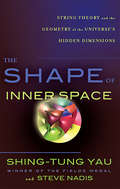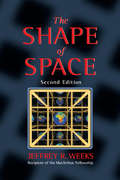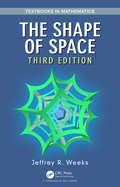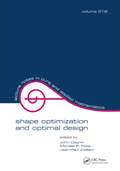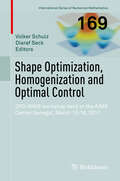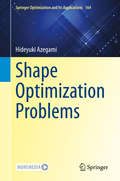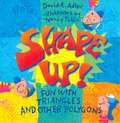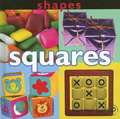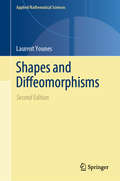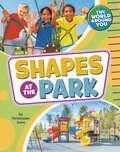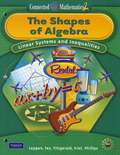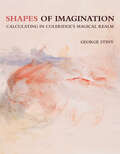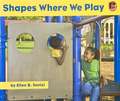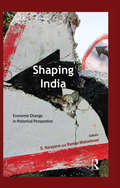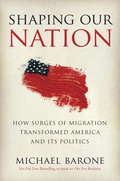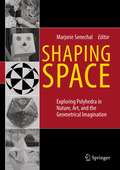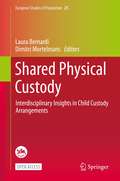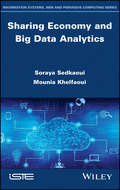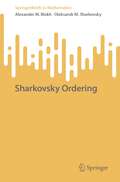- Table View
- List View
The Shape of Inner Space: String Theory and the Geometry of the Universe's Hidden Dimensions
by Shing-Tung Yau Steve NadisString theory says we live in a ten-dimensional universe, but that only four are accessible to our everyday senses. According to theorists, the missing six are curled up in bizarre structures known as Calabi-Yau manifolds. In The Shape of Inner Space, Shing-Tung Yau, the man who mathematically proved that these manifolds exist, argues that not only is geometry fundamental to string theory, it is also fundamental to the very nature of our universe.Time and again, where Yau has gone, physics has followed. Now for the first time, readers will follow Yau's penetrating thinking on where we've been, and where mathematics will take us next. A fascinating exploration of a world we are only just beginning to grasp, The Shape of Inner Space will change the way we consider the universe on both its grandest and smallest scales.
The Shape of Space (Chapman & Hall/CRC Pure and Applied Mathematics #249)
by Jeffrey R. WeeksMaintaining the standard of excellence set by the previous edition, this textbook covers the basic geometry of two- and three-dimensional spaces Written by a master expositor, leading researcher in the field, and MacArthur Fellow, it includes experiments to determine the true shape of the universe and contains illustrated examples and engaging exercises that teach mind-expanding ideas in an intuitive and informal way. Bridging the gap from geometry to the latest work in observational cosmology, the book illustrates the connection between geometry and the behavior of the physical universe and explains how radiation remaining from the big bang may reveal the actual shape of the universe.
The Shape of Space: How To Visualize Surfaces And Three-dimensional Manifolds (Textbooks in Mathematics #Vol. 249)
by Jeffrey R. WeeksThe Shape of Space, Third Edition maintains the standard of excellence set by the previous editions. This lighthearted textbook covers the basic geometry and topology of two- and three-dimensional spaces—stretching students’ minds as they learn to visualize new possibilities for the shape of our universe. Written by a master expositor, leading researcher in the field, and MacArthur Fellow, its informal exposition and engaging exercises appeal to an exceptionally broad audience, from liberal arts students to math undergraduate and graduate students looking for a clear intuitive understanding to supplement more formal texts, and even to laypeople seeking an entertaining self-study book to expand their understanding of space. Features of the Third Edition: Full-color figures throughout "Picture proofs" have replaced algebraic proofs Simpler handles-and-crosscaps approach to surfaces Updated discussion of cosmological applications Intuitive examples missing from many college and graduate school curricula About the Author: Jeffrey R. Weeks is a freelance geometer living in Canton, New York. With support from the U.S. National Science Foundation, the MacArthur Foundation and several science museums, his work spans pure mathematics, applications in cosmology and—closest to his heart—exposition for the general public.
Shape Optimization And Optimal Design
by John Cagnol Michael P. Polis Jean-Paul ZolésioThis volume presents developments and advances in modelling passive and active control systems governed by partial differential equations. It emphasizes shape analysis, optimal shape design, controllability, nonlinear boundary control, and stabilization. The authors include essential data on exact boundary controllability of thermoelastic plates with variable transmission coefficients.
Shape Optimization, Homogenization and Optimal Control: DFG-AIMS workshop held at the AIMS Center Senegal, March 13-16, 2017 (International Series of Numerical Mathematics #169)
by Volker Schulz Diaraf SeckThe contributions in this volume give an insight into current research activities in Shape Optimization, Homogenization and Optimal Control performed in Africa, Germany and internationally. Seeds for collaboration can be found in the first four papers in the field of homogenization. Modelling and optimal control in partial differential equations is the topic of the next six papers, again mixed from Africa and Germany. Finally, new results in the field of shape optimization are discussed in the final international three papers.This workshop, held at the AIMS Center Senegal, March 13-16, 2017, has been supported by the Deutsche Forschungsgemeinschaft (DFG) and by the African Institute for Mathematical Sciences (AIMS) in Senegal, which is one of six centres of a pan-African network of centres of excellence for postgraduate education, research and outreach in mathematical sciences.
Shape Optimization Problems (Springer Optimization and Its Applications #164)
by Hideyuki AzegamiThis book provides theories on non-parametric shape optimization problems, systematically keeping in mind readers with an engineering background. Non-parametric shape optimization problems are defined as problems of finding the shapes of domains in which boundary value problems of partial differential equations are defined. In these problems, optimum shapes are obtained from an arbitrary form without any geometrical parameters previously assigned. In particular, problems in which the optimum shape is sought by making a hole in domain are called topology optimization problems. Moreover, a problem in which the optimum shape is obtained based on domain variation is referred to as a shape optimization problem of domain variation type, or a shape optimization problem in a limited sense. Software has been developed to solve these problems, and it is being used to seek practical optimum shapes. However, there are no books explaining such theories beginning with their foundations.The structure of the book is shown in the Preface. The theorems are built up using mathematical results. Therefore, a mathematical style is introduced, consisting of definitions and theorems to summarize the key points. This method of expression is advanced as provable facts are clearly shown. If something to be investigated is contained in the framework of mathematics, setting up a theory using theorems prepared by great mathematicians is thought to be an extremely effective approach. However, mathematics attempts to heighten the level of abstraction in order to understand many things in a unified fashion. This characteristic may baffle readers with an engineering background. Hence in this book, an attempt has been made to provide explanations in engineering terms, with examples from mechanics, after accurately denoting the provable facts using definitions and theorems.
Shape Up!: Fun with triangles and other polygons
by David A. AdlerUses cheese slices, pretzel sticks, a slice of bread, graph paper, a pencil, and more to introduce various polygons, flat shapes with varying numbers of straight sides.
Shapes: Squares (Concepts)
by Esther SarfattiToys are square! Foods are square! Squares are everywhere! Other books by this author are available in this library.
Shapes and Designs: Two-Dimensional Geometry (Connected Mathematics)
by Glenda Lappan Elizabeth Difanis Phillips James T. Fey Susan N. FrielThe contents of this book include: The Family of Polygons, Designing Polygons: The Angle Connection, Designing Triangles and Quadrilaterals, English/Spanish Glossary, etc.
Shapes and Designs: Two-Dimensional Geometry
by Glenda Lappan Elizabeth Difanis Phillips James T. Fey Susan N. FrielNIMAC-sourced textbook
Shapes and Designs, Two - Dimensional Geometry
by Glenda Lappan James T. Fey William M. Fitzgerald Susan N. Friel Elizabeth Difanis PhillipsNIMAC-sourced textbook
Shapes and Diffeomorphisms (Applied Mathematical Sciences #171)
by Laurent YounesThis book covers mathematical foundations and methods for the computerized analysis of shapes, providing the requisite background in geometry and functional analysis and introducing various algorithms and approaches to shape modeling, with a special focus on the interesting connections between shapes and their transformations by diffeomorphisms. A direct application is to computational anatomy, for which techniques such as large‒deformation diffeomorphic metric mapping and metamorphosis, among others, are presented. The appendices detail a series of classical topics (Hilbert spaces, differential equations, Riemannian manifolds, optimal control).The intended audience is applied mathematicians and mathematically inclined engineers interested in the topic of shape analysis and its possible applications in computer vision or medical imaging. The first part can be used for an advanced undergraduate course on differential geometry with a focus on applications while the later chapters are suitable for a graduate course on shape analysis through the action of diffeomorphisms. Several significant additions appear in the 2nd edition, most notably a new chapter on shape datasets, and a discussion of optimal control theory in an infinite-dimensional framework, which is then used to enrich the presentation of diffeomorphic matching.
Shapes at the Park (The World Around You)
by Christianne JonesFrom rectangular ladders to circular rings and hexagonal picnic tables, the park is full of shapes! Finding shapes adds even more fun to a day at the park, and early learners will be fully engaged with the interactive, rhyming text and colorful photos in this picture book.
The Shapes of Algebra, Linear Systems and Inequalities
by Glenda Lappan James T. Fey William M. Fitzgerald Susan N. Friel Elizabeth Difanis PhillipsNIMAC-sourced textbook
Shapes of Imagination: Calculating in Coleridge's Magical Realm
by George StinyVisual calculating in shape grammars aligns with art and design, bridging the gap between seeing (Coleridge's &“imagination&”) and combinatoric play (Coleridge's &“fancy&”).In Shapes of Imagination, George Stiny runs visual calculating in shape grammars through art and design—incorporating Samuel Taylor Coleridge's poetic imagination and Oscar Wilde's corollary to see things as they aren't. Many assume that calculating limits art and design to suit computers, but shape grammars rely on seeing to prove otherwise. Rules that change what they see extend calculating to overtake what computers can do, in logic and with data and learning. Shape grammars bridge the divide between seeing (Coleridge's &“imagination, or esemplastic power&”) and combinatoric play (Coleridge's &“fancy&”).Stiny shows that calculating without seeing excludes art and design. Seeing is key for calculating to augment creative activity with aesthetic insight and value. Shape grammars go by appearances, in a full-fledged aesthetic enterprise for the inconstant eye; they answer the question of what calculating would be like if Turing and von Neumann were artists instead of logicians. Art and design are calculating in all their splendid detail.
Shaping India: Economic Change in Historical Perspective
by D. Narayana; Raman MahadevanThis volume seeks to unravel and contextualize the so-called dichotomy of ‘old’ and ‘new’ India and what binds them together. To understand this complex process, it attempts to apply a long-term historical perspective, a different conception of the economy and cross-disciplinary approaches. The exceptional feature of this volume is the large historical canvas of essays and its sensitivity to the regional dimension in a country as large and diverse as India. They deal with issues ranging from land and agriculture, entrepreneurship, industry and demographic trends to a critical anatomy of modern Indian economic historiography. Together these essays contribute in providing significantly new and enriching insights into the complex process of transition from colonial to post-colonial economic development. There has been a conscious effort in most cases to capture the influence of the colonial economic structures and processes in shaping the trajectory of growth and development in the post-independence period. Drawing upon a large amount of extremely rich and varied data and information on the socio-economic trends, the book is lucid, well-crafted and reader-friendly.
Shaping Our Nation
by Michael BaroneIt is often said that America has become culturally diverse only in the past quarter century. But from the country's beginning, cultural variety and conflict have been a centrifugal force in American politics and a crucial reason for our rise to power. The peopling of the United States is one of the most important stories of the last five hundred years, and in Shaping our Nation, bestselling author and demographics expert Michael Barone illuminates a new angle on America's rise, using a vast array of political and social data to show America is the product of a series large, unexpected mass movements--both internal and external--which typically lasted only one or two generations but in that time reshaped the nation, and created lasting tensions that were difficult to resolve. Barone highlights the surprising trends and connections between the America of today and its migrant past, such as how the areas of major Scots-Irish settlement in the years leading up to the Revolutionary War are the same areas where John McCain performed better in the 2008 election than George W. Bush did in 2004, and how in the years following the Civil War, migration across the Mason-Dixon line all but ceased until the annealing effect that the shared struggle of World War II produced. Barone also takes us all the way up to present day, showing what the surge of Hispanic migration between 1970 and 2010 means for the elections and political decisions to be made in the coming decades. Barone shows how, from the Scots-Irish influxes of the 18th century, to the Ellis Island migrations of the early 20th and the Hispanic and Asian ones of the last four decades, people have moved to America in part in order to make a better living--but more importantly, to create new communities in which they could thrive and live as they wanted. And the founders' formula of limited government, civic equality, and tolerance of religious and cultural diversity has provided a ready and useful template for not only to coping with these new cultural influences, but for prospering as a nation with cultural variety. Sweeping, thought-provoking, and ultimately hopeful, Shaping Our Nation is an unprecedented addition to our understanding of America's cultural past, with deep implications for the immigration, economic, and social policies of the future. From the Hardcover edition.
Shaping Space
by Marjorie SenechalThis second edition is based off of the very popular Shaping Space: A Polyhedral Approach, first published twenty years ago. The book is expanded and updated to include new developments, including the revolutions in visualization and model-making that the computer has wrought. Shaping Space is an exuberant, richly-illustrated, interdisciplinary guide to three-dimensional forms, focusing on the suprisingly diverse world of polyhedra. Geometry comes alive in Shaping Space, as a remarkable range of geometric ideas is explored and its centrality in our cultre is persuasively demonstrated. The book is addressed to designers, artists, architects, engineers, chemists, computer scientists, mathematicians, bioscientists, crystallographers, earth scientists, and teachers at all levels--in short, to all scholars and educators interested in, and working with, two- and three-dimensinal structures and patterns.
The Shapley value: Essays in honor of Lloyd S. Shapley
by Alvin E. RothComposed in honour of the sixty-fifth birthday of Lloyd Shapley, this volume makes accessible the large body of work that has grown out of Shapley's seminal 1953 paper. Each of the twenty essays concerns some aspect of the Shapley value. Three of the chapters are reprints of the 'ancestral' papers: Chapter 2 is Shapley's original 1953 paper defining the value; Chapter 3 is the 1954 paper by Shapley and Shubik applying the value to voting models; and chapter 19 is Shapley's 1969 paper defining a value for games without transferable utility. The other seventeen chapters were contributed especially for this volume. The first chapter introduces the subject and the other essays in the volume, and contains a brief account of a few of Shapley's other major contributions to game theory. The other chapters cover the reformulations, interpretations and generalizations that have been inspired by the Shapley value, and its applications to the study of coalition formulation, to the organization of large markets, to problems of cost allocation, and to the study of games in which utility is not transferable.
Shared Beginnings, Divergent Lives: Delinquent Boys to Age 70
by John H. Laub Robert J. SampsonThis book analyzes newly collected data on crime and social development up to age 70 for 500 men who were remanded to reform school in the 1940s. Born in Boston in the late 1920s and early 1930s, these men were the subjects of the classic study Unraveling Juvenile Delinquency by Sheldon and Eleanor Glueck (1950). Updating their lives at the close of the twentieth century, and connecting their adult experiences to childhood, this book is arguably the longest longitudinal study of age, crime, and the life course to date. John Laub and Robert Sampson's long-term data, combined with in-depth interviews, defy the conventional wisdom that links individual traits such as poor verbal skills, limited self-control, and difficult temperament to long-term trajectories of offending. The authors reject the idea of categorizing offenders to reveal etiologies of offending--rather, they connect variability in behavior to social context. They find that men who desisted from crime were rooted in structural routines and had strong social ties to family and community. By uniting life-history narratives with rigorous data analysis, the authors shed new light on long-term trajectories of crime and current policies of crime control.
Shared Physical Custody: Interdisciplinary Insights in Child Custody Arrangements (European Studies of Population #25)
by Laura Bernardi Dimitri MortelmansThis open access book provides an overview of the ever-growing phenomenon of children in shared physical custody thereby providing legal, psychological, family sociological and demographical insights. It describes how, despite the long evolution of broken families, only the last decade has seen a radical shift in custody arrangements for children in divorced families and the gender revolution in parenting which is taking place. The chapters have a national or cross-national perspective and address topics like prevalence and types of shared physical custody, legal frames regulating custody arrangements, stability and changes in arrangements across the life course of children, socio‐economic, psychological, social well-being of various family members involved in different custody arrangements. With the book being an interdisciplinary collaboration, it is interesting read for social scientists in demography, sociology, psychology, law and policy makers with an interest family studies and custody arrangements.
Sharing Economy and Big Data Analytics
by Soraya Sedkaoui Mounia KhelfaouiThe different facets of the sharing economy offer numerous opportunities for businesses ? particularly those that can be distinguished by their creative ideas and their ability to easily connect buyers and senders of goods and services via digital platforms. At the beginning of the growth of this economy, the advanced digital technologies generated billions of bytes of data that constitute what we call Big Data. This book underlines the facilitating role of Big Data analytics, explaining why and how data analysis algorithms can be integrated operationally, in order to extract value and to improve the practices of the sharing economy. It examines the reasons why these new techniques are necessary for businesses of this economy and proposes a series of useful applications that illustrate the use of data in the sharing ecosystem.
Sharkovsky Ordering (SpringerBriefs in Mathematics)
by Alexander M. Blokh Oleksandr M. SharkovskyThis book provides a comprehensive survey of the Sharkovsky ordering, its different aspects and its role in dynamical systems theory and applications. It addresses the coexistence of cycles for continuous interval maps and one-dimensional spaces, combinatorial dynamics on the interval and multidimensional dynamical systems. Also featured is a short chapter of personal remarks by O.M. Sharkovsky on the history of the Sharkovsky ordering, the discovery of which almost 60 years ago led to the inception of combinatorial dynamics. Now one of cornerstones of dynamics, bifurcation theory and chaos theory, the Sharkovsky ordering is an important tool for the investigation of dynamical processes in nature. Assuming only a basic mathematical background, the book will appeal to students, researchers and anyone who is interested in the subject.
